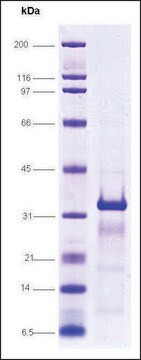推荐产品
生物源
human
重組細胞
expressed in insect cells
化驗
≥80% (SDS-PAGE)
形狀
frozen liquid
分子量
~51.6 kDa
包裝
pkg of 5 μg
儲存條件
avoid repeated freeze/thaw cycles
濃度
650 μg/mL
顏色
clear colorless
NCBI登錄號
UniProt登錄號
運輸包裝
dry ice
儲存溫度
−70°C
基因資訊
human ... NR1I2(8856)
生化/生理作用
The nuclear pregnane X receptor (PXR; NR1I2) is an important component of the body′s adaptive defense mechanism against toxic substances including foreign chemicals (xenobiotics). PXR is activated by a large number of endogenous and exogenous chemicals including steroids, antibiotics, antimycotics, bile acids, and the herbal antidepressant St. John′s wort. PXR is known to regulate the expression of several additional genes encoding proteins involved in xenobiotic metabolism, including multidrug resistance protein 1 (MDR1), multidrug resistance-associated protein 2 (MRP2), and organic anion transporter polypeptide 2. Elucidation of the three-dimensional structure of the PXR ligand binding domain revealed that it has a large, spherical ligand binding cavity that allows it to interact with a wide range of hydrophobic chemicals. Thus, unlike other nuclear receptors that interact selectively with their physiological ligands, PXR serves as a generalized sensor of hydrophobic toxins. PXR binds as a heterodimer with the 9-cis retinoic acid receptor (NR2B) to DNA response elements in the regulatory regions of cytochrome P450 3A monooxygenase genes and a number of other genes involved in the metabolism and elimination of xenobiotics from the body. Although PXR evolved to protect the body, its activation by a variety of prescription drugs represents the molecular basis for an important class of harmful drug-drug interactions. Thus, assays that detect PXR activity will be useful in developing safer prescription drugs.
外觀
Clear and colorless frozen liquid solution
準備報告
Use a manual defrost freezer and avoid repeated freeze-thaw cycles. While working, please keep sample on ice.
儲存類別代碼
12 - Non Combustible Liquids
水污染物質分類(WGK)
WGK 1
閃點(°F)
Not applicable
閃點(°C)
Not applicable
G Bertilsson et al.
Proceedings of the National Academy of Sciences of the United States of America, 95(21), 12208-12213 (1998-10-15)
Nuclear receptors regulate metabolic pathways in response to changes in the environment by appropriate alterations in gene expression of key metabolic enzymes. Here, a computational search approach based on iteratively built hidden Markov models of nuclear receptors was used to
P Honkakoski et al.
The Biochemical journal, 347(Pt 2), 321-337 (2000-04-06)
Members of the nuclear-receptor superfamily mediate crucial physiological functions by regulating the synthesis of their target genes. Nuclear receptors are usually activated by ligand binding. Cytochrome P450 (CYP) isoforms often catalyse both formation and degradation of these ligands. CYPs also
D J Waxman
Archives of biochemistry and biophysics, 369(1), 11-23 (1999-08-27)
The biochemistry of foreign compound metabolism and the roles played by individual cytochrome P450 (CYP) enzymes in drug metabolism and in the toxification and detoxification of xenochemicals prevalent in the environment are important areas of molecular pharmacology and toxicology that
Andreas Elentner et al.
Experimental dermatology, 24(11), 835-840 (2015-05-28)
Skin is in daily contact with potentially harmful molecules from the environment such as cigarette smoke, automobile emissions, industrial soot and groundwater. Pregnane X receptor (PXR) is a transcription factor expressed in liver and intestine that is activated by xenobiotic
我们的科学家团队拥有各种研究领域经验,包括生命科学、材料科学、化学合成、色谱、分析及许多其他领域.
联系技术服务部门








